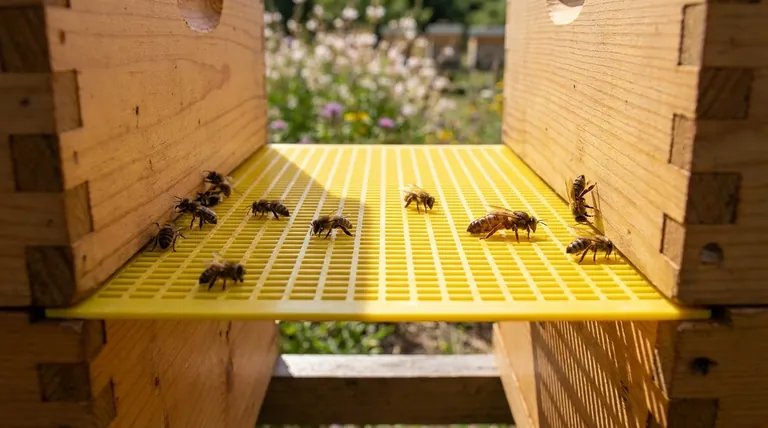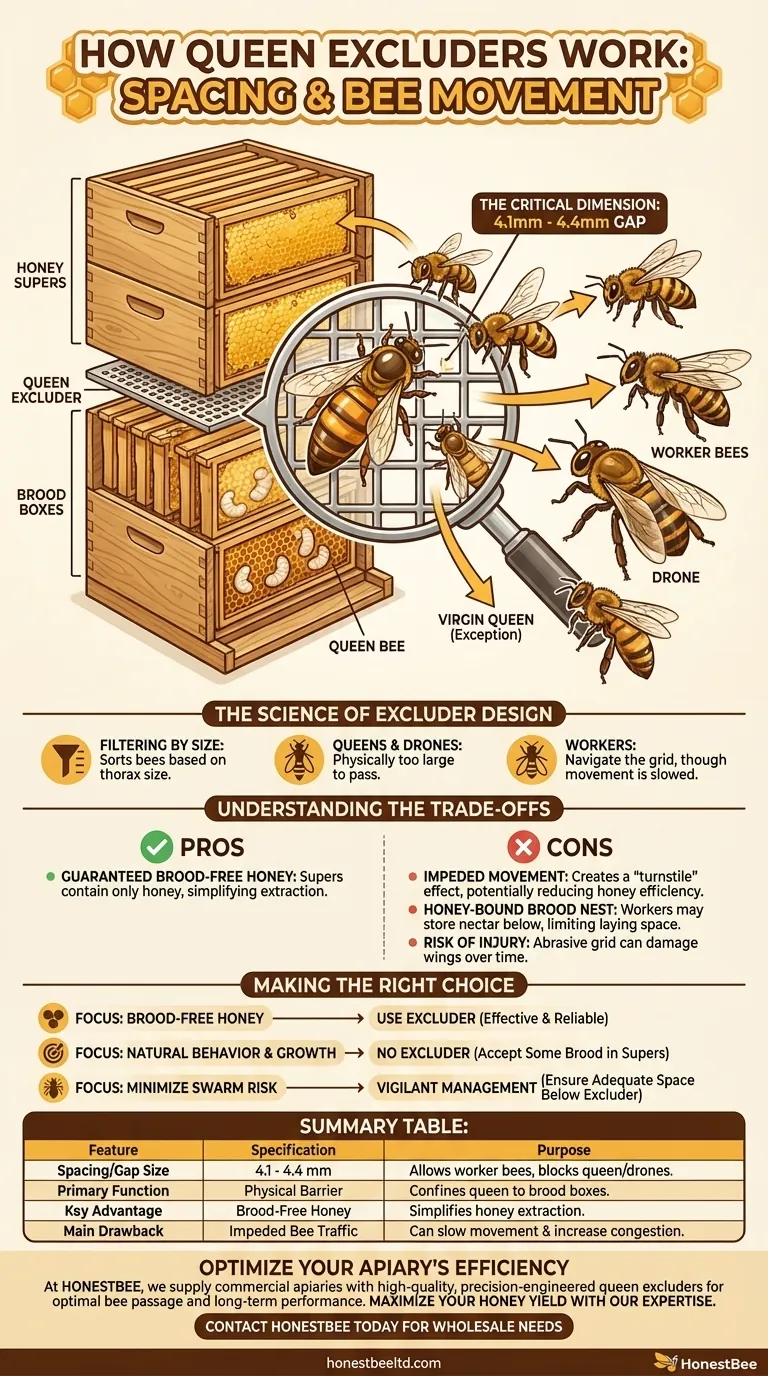At its core, a queen excluder is a precision-engineered gate that leverages the size difference between bees in a colony. Its purpose is to confine the larger queen bee to the lower brood boxes, preventing her from laying eggs in the honey supers above. This is achieved through a grid with gaps measuring between 4.1 and 4.4 millimeters—wide enough for smaller worker bees to pass through but too narrow for a mature, mated queen and the even larger drones.
A queen excluder physically isolates the queen to ensure brood-free honey supers, simplifying extraction. However, this control is not without cost, as the barrier can impede worker bee movement, reduce overall hive efficiency, and require careful management to prevent congestion.

The Science of Excluder Design
The function of a queen excluder is rooted in the distinct anatomy of the different members of a honey bee colony. The design is not arbitrary; it is a direct application of these physical differences.
The Critical Dimension: 4.1mm to 4.4mm
This specific spacing is the key to the excluder's function. It is the result of careful measurement and observation of bee morphology. This dimension acts as a filter, sorting bees by the size of their thorax.
Why Queens and Drones are Blocked
A mature, mated queen has a larger thorax and abdomen than her workers. She is physically too big to fit through the gaps. Likewise, male drones are significantly larger and bulkier than workers and are also reliably blocked by the excluder.
How Workers Pass Through
Worker bees have a smaller thorax, allowing them to squeeze through the gaps. While they can pass, it is not an effortless process. They must navigate the grid, which can slow traffic flow into and out of the honey supers.
The Virgin Queen Exception
An important exception is a young, virgin queen. Before she is mated, her abdomen has not yet enlarged with developed ovaries. In this state, she may be small enough to slip through an excluder, which is a critical consideration during swarm control or queen replacement.
Understanding the Trade-offs
Using a queen excluder is one of the most debated topics in beekeeping. It is a management tool with clear benefits and significant drawbacks that affect the colony's natural behavior.
Pro: Guaranteed Brood-Free Honey
The primary advantage is clear separation. By keeping the queen in the brood nest, beekeepers can be certain that honey supers will contain only honey, not eggs, larvae, or pupae. This makes the honey extraction process cleaner and simpler.
Con: Impeded Movement and Reduced Efficiency
The excluder creates a "turnstile" effect. Bees returning with nectar may be slowed, creating a bottleneck that reduces the overall efficiency of honey storage. Some beekeepers argue this barrier can lead to a lower honey yield over the season.
Con: Potential for a "Honey-Bound" Brood Nest
Because workers may be reluctant to cross the barrier, they can begin storing nectar in the brood chamber instead of the supers. This fills cells the queen needs for laying, a condition known as being honey-bound, which can restrict colony growth and increase swarm pressure.
Con: Risk of Bee Injury
Movement through the tight grid can be abrasive. Bees can sometimes sustain damage, particularly to their wings. While often minor, this cumulative wear and tear can shorten the lifespan of individual foragers.
Making the Right Choice for Your Hive
The decision to use a queen excluder depends entirely on your beekeeping philosophy and goals. There is no single correct answer, only the right choice for your situation.
- If your primary focus is pure, brood-free honey for extraction: An excluder is a highly effective and reliable tool for achieving this goal.
- If your primary focus is maximizing natural colony behavior and population growth: You might choose to manage without an excluder, allowing the queen to move freely and accepting some brood in the honey frames.
- If your primary focus is minimizing swarm risk: Be vigilant. An excluder can increase congestion in the brood nest, so you must ensure the colony has adequate space below the excluder to expand.
Ultimately, understanding the excluder as a tool of control—with both benefits and costs—allows you to make the best decision for your specific management style and the health of your hive.
Summary Table:
| Feature | Specification | Purpose |
|---|---|---|
| Spacing/Gap Size | 4.1 - 4.4 mm | Allows worker bees to pass but blocks the larger queen and drones. |
| Primary Function | Physical Barrier | Confines the queen to the brood boxes, preventing eggs in honey supers. |
| Key Advantage | Brood-Free Honey | Simplifies honey extraction by ensuring supers contain only honey. |
| Main Drawback | Impeded Bee Traffic | Can slow worker movement, potentially reducing honey yield and increasing congestion. |
Optimize Your Apiary's Efficiency with the Right Equipment
Managing hive traffic and honey production is a delicate balance. At HONESTBEE, we supply commercial apiaries and beekeeping equipment distributors with high-quality, precision-engineered supplies—including durable queen excluders designed for optimal bee passage and long-term performance.
Let our expertise help you maximize your honey yield and streamline your operations. Contact HONESTBEE today to discuss your wholesale needs and discover how our equipment can benefit your business.
Visual Guide

Related Products
- Professional Plastic Queen Excluder for Modern Beekeeping
- Premium Wood Framed Metal Wire Queen Bee Excluder
- Wooden Queen Bee Excluder for Beekeeping
- Plastic Queen Bee Excluder for Bee Hive Wholesale
- High Performance Plastic Queen Excluder for Beekeeping and Apiary Management
People Also Ask
- What are the pros of using a queen excluder? Boost Hive Control & Honey Quality
- What is the purpose of a queen excluder when adding a super? Streamline Your Honey Harvest
- What is a Queen Excluder and how does it work? Achieve Purer Honey & Better Hive Control
- What is the role of a queen excluder when adding a super? Ensure Brood-Free Honey Harvests
- What is the primary function of a queen excluder in beekeeping? Control Hive Layout for Efficient Honey Harvesting



















